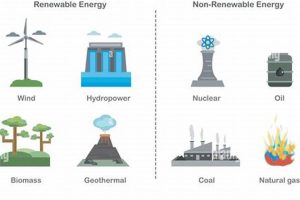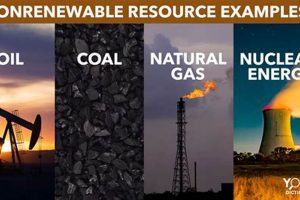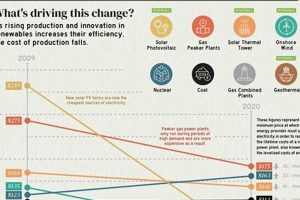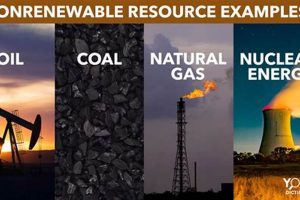Energy sources are broadly categorized into two fundamental types: those that replenish naturally over a relatively short period, and those that exist in finite quantities and are depleted with use. Solar, wind, hydro, geothermal, and biomass exemplify the former, deriving power from ongoing natural processes. Fossil fuels (coal, oil, and natural gas) and nuclear energy, derived from uranium, represent the latter, their formation taking millions of years.
The distinction between these energy types carries significant implications for environmental sustainability and long-term energy security. Sources that replenish naturally offer a pathway to reduce reliance on finite resources and mitigate the environmental impacts associated with their extraction and combustion. This transition to sustainable practices began gaining traction in the late 20th century as awareness of climate change and resource depletion grew. The historical reliance on fossil fuels has shaped global energy infrastructure and economies, presenting both challenges and opportunities in the shift toward more sustainable alternatives.
This article will further explore the specific advantages and disadvantages of each energy type, examining their economic viability, technological advancements, and role in the global energy landscape. Detailed analysis will be provided for each source, highlighting current utilization trends and future prospects.
Tips for Transitioning to Sustainable Energy Practices
Shifting towards sustainable energy sources requires a multifaceted approach encompassing individual actions, policy changes, and technological advancements. The following tips provide practical guidance for promoting a more sustainable energy future.
Tip 1: Improve Energy Efficiency: Reducing energy consumption through improved insulation, energy-efficient appliances, and behavioral changes like reducing standby power consumption minimizes the overall energy demand, regardless of the source.
Tip 2: Invest in Renewable Energy Technologies: Supporting the development and adoption of renewable energy technologies, such as solar panels and wind turbines, accelerates the transition to a cleaner energy mix.
Tip 3: Advocate for Supportive Policies: Policies that incentivize renewable energy development, implement carbon pricing mechanisms, and promote energy efficiency standards are crucial for driving systemic change.
Tip 4: Support Sustainable Transportation: Transitioning to electric vehicles, utilizing public transportation, and promoting cycling and walking reduce reliance on fossil fuels in the transportation sector.
Tip 5: Educate and Raise Awareness: Promoting understanding of the benefits of sustainable energy and the urgency of climate action fosters broader public support for the necessary transitions.
Tip 6: Invest in Research and Development: Continued research and development in energy storage solutions, smart grid technologies, and next-generation renewable energy technologies are essential for long-term sustainability.
Tip 7: Diversify Energy Sources: Relying on a diverse mix of renewable energy sources enhances energy security and resilience against fluctuations in resource availability and environmental conditions.
By implementing these strategies, significant progress can be made towards a future powered by clean, sustainable energy, mitigating the impacts of climate change and ensuring long-term energy security.
The following sections will delve deeper into specific renewable and non-renewable energy sources, examining their individual characteristics and contributions to the global energy landscape.
1. Resource Availability (Finite vs. Infinite)
Resource availability stands as a fundamental differentiator between renewable and non-renewable energy sources. Non-renewable resources, such as coal, oil, and natural gas, are finite. Their formation takes millions of years, and current consumption rates vastly exceed their replenishment rate. This finite nature necessitates careful management and exploration of alternative energy sources to ensure long-term energy security. Depletion of these resources has significant economic and geopolitical implications, driving price volatility and potentially leading to resource conflicts.
Conversely, renewable resources like solar, wind, hydro, and geothermal energy are virtually inexhaustible. Solar energy, derived from the sun, and wind energy, driven by atmospheric pressure differences, are continuously replenished. Hydropower harnesses the natural water cycle, and geothermal energy taps into the Earth’s internal heat. While some renewable resources, like biomass, are technically finite, sustainable management practices can ensure their continuous availability. This inherent replenishing characteristic of renewable resources positions them as a cornerstone of sustainable energy strategies, offering long-term stability and mitigating the risks associated with resource depletion.
The distinction between finite and infinite resources underscores the critical importance of transitioning towards a renewable energy future. Continued reliance on finite resources presents significant risks, including resource depletion, price volatility, and environmental degradation. Embracing renewable energy technologies and sustainable resource management practices provides a pathway towards a more secure, stable, and environmentally responsible energy future. This transition requires strategic investments in research, infrastructure development, and policy frameworks that incentivize the adoption of renewable energy solutions.
2. Environmental Impact (Pollution vs. Clean)
A crucial aspect of the renewable vs. non-renewable energy discourse centers on their respective environmental impacts. Non-renewable energy sources are inherently linked to substantial pollution, contributing significantly to climate change and other environmental problems. Renewable sources, on the other hand, offer a cleaner alternative, minimizing environmental damage and promoting a sustainable future. Understanding these contrasting impacts is vital for informed energy choices.
- Greenhouse Gas Emissions
Combustion of fossil fuels releases substantial greenhouse gases, primarily carbon dioxide, into the atmosphere. These gases trap heat, leading to global warming and climate change. Examples include the emissions from coal-fired power plants and gasoline-powered vehicles. Renewable energy sources like solar and wind power produce minimal greenhouse gases during operation, significantly reducing the contribution to climate change.
- Air and Water Quality
Fossil fuel extraction and combustion contribute to air and water pollution. Coal mining can lead to acid mine drainage, contaminating water sources. Burning fossil fuels releases pollutants such as sulfur dioxide and nitrogen oxides, contributing to acid rain and respiratory problems. Renewable energy sources generally have a much lower impact on air and water quality. For instance, solar panels produce no emissions during operation, and wind turbines have a relatively small footprint.
- Land Use and Habitat Disruption
Extraction of fossil fuels, particularly coal mining and oil drilling, can significantly disrupt land use and ecosystems. Mining operations can lead to deforestation, habitat loss, and soil erosion. Renewable energy sources also require land use, but their overall impact is often less severe. For example, solar farms can be integrated into existing landscapes, and offshore wind farms minimize land disruption.
- Waste Disposal
Nuclear power generation produces radioactive waste that requires long-term storage and careful management. Fossil fuel combustion generates ash and other byproducts that require disposal. Renewable energy sources produce minimal waste, although end-of-life management of components like solar panels and wind turbine blades requires consideration. Recycling and proper disposal methods minimize the environmental impact of these materials.
The environmental impacts of energy production are a critical factor in determining long-term sustainability. The shift towards renewable energy sources offers a pathway to mitigate pollution, reduce greenhouse gas emissions, and protect ecosystems. While renewable energy technologies also present certain environmental considerations, their overall impact is significantly lower compared to non-renewable sources. A comprehensive approach to energy policy must prioritize minimizing environmental harm and maximizing the utilization of clean, renewable resources.
3. Cost (Fluctuating vs. Stable)
Cost considerations play a significant role in the ongoing transition from non-renewable to renewable energy sources. The economic implications of each energy type differ substantially, impacting both individual consumers and national economies. Examining the cost dynamics inherent in both non-renewable and renewable energy options is essential for informed decision-making and effective policy development. Price volatility, long-term cost trends, and the economic impacts of externalities are all crucial factors in this analysis.
- Fuel Price Volatility
Non-renewable energy sources, particularly fossil fuels, are subject to significant price fluctuations due to geopolitical events, supply chain disruptions, and fluctuating demand. These price swings can create economic instability for consumers and businesses reliant on these energy sources. Renewable energy sources, while requiring upfront investment, are largely insulated from these volatile fuel markets, offering greater price stability over the long term. Once installed, solar and wind power, for example, have minimal operating costs, reducing exposure to price fluctuations.
- Long-Term Cost Trends
While the initial investment for renewable energy technologies can be higher than for non-renewable counterparts, long-term cost trends favor renewables. The cost of solar and wind power has decreased dramatically in recent years due to technological advancements and economies of scale. Conversely, the cost of extracting and processing fossil fuels tends to increase over time as easily accessible reserves are depleted, requiring more complex and expensive extraction methods.
- Externalities and Subsidies
The true cost of energy must account for externalities, the indirect costs or benefits not reflected in market prices. Non-renewable energy sources generate significant negative externalities, such as air pollution and climate change impacts, which impose costs on society. Renewable energy sources have far fewer negative externalities. Government subsidies can influence the market price of both renewable and non-renewable energy sources, impacting investment decisions and consumer choices.
- Grid Infrastructure and Storage
Integrating renewable energy sources into existing power grids often requires upgrades and investments in grid infrastructure. Additionally, the intermittent nature of solar and wind power necessitates energy storage solutions to ensure reliable power supply. These infrastructure and storage costs are important factors in the overall cost assessment of renewable energy systems. Advancements in battery technology and smart grid management are driving down these costs and improving grid integration.
A comprehensive cost analysis demonstrates that while renewable energy technologies may require higher initial investments, their long-term cost trajectory, price stability, and reduced externalities offer significant economic advantages over non-renewable sources. As technology continues to advance and economies of scale are realized, renewable energy is becoming increasingly cost-competitive, paving the way for a sustainable and economically viable energy future. Understanding these complex cost dynamics is crucial for policymakers, businesses, and individuals seeking to make informed decisions about energy consumption and investment.
4. Energy Security (Dependence vs. Independence)
Energy security is a critical dimension of national and international stability, encompassing the reliable availability of energy resources at affordable prices. The choice between renewable and non-renewable energy sources significantly impacts a nation’s energy security profile. Reliance on non-renewable resources, often concentrated geographically, can create dependencies on volatile global markets and potentially unstable political regimes. Conversely, diversified renewable energy portfolios enhance energy independence and resilience.
- Geopolitical Vulnerability
Dependence on imported fossil fuels exposes nations to geopolitical risks, including price volatility, supply disruptions, and political instability in exporting regions. This vulnerability can compromise energy security and hinder economic growth. Renewable energy sources, being more geographically dispersed, mitigate these risks by enabling nations to generate power domestically, reducing reliance on international energy markets and enhancing energy independence. For example, countries heavily reliant on imported natural gas may face price spikes or supply disruptions due to political conflicts or pipeline issues, while those with substantial solar and wind capacity are less vulnerable to such external pressures.
- Resource Depletion
Non-renewable energy sources are finite and subject to depletion. As readily accessible reserves diminish, extraction becomes more complex and expensive, potentially jeopardizing long-term energy security. Transitioning to renewable energy sources mitigates this risk by utilizing resources that are virtually inexhaustible, such as solar and wind power. This shift reduces dependence on finite resources and promotes a more sustainable energy future, lessening the risk of future energy shortages. For instance, reliance on coal-fired power plants faces the challenge of dwindling coal reserves and increasing extraction costs, while solar power remains readily available.
- Supply Chain Disruptions
Global supply chains for fossil fuels are vulnerable to disruptions from various factors, including natural disasters, pandemics, and geopolitical instability. These disruptions can impact energy availability and prices, undermining energy security. Renewable energy systems, particularly distributed generation models like rooftop solar, are less susceptible to large-scale supply chain disruptions. Local generation reduces dependence on complex global supply chains, enhancing energy resilience. For example, a major oil spill can disrupt oil supplies, while localized solar power generation remains unaffected.
- Energy Diversification
Diversifying energy sources enhances energy security by reducing reliance on any single source. Utilizing a mix of renewable energy technologies, such as solar, wind, hydro, and geothermal, creates a more resilient energy portfolio less vulnerable to disruptions affecting any one specific resource. This diversification strategy minimizes dependence on both fossil fuels and individual renewable energy sources, strengthening overall energy security. For instance, a country relying solely on hydropower might experience energy shortages during droughts, while a diversified portfolio including solar and wind power provides greater stability.
The pursuit of energy security is intrinsically linked to the transition from non-renewable to renewable energy sources. Renewable energy offers a pathway to greater energy independence, resilience, and long-term sustainability. By reducing reliance on finite and geographically concentrated resources, renewable energy empowers nations to control their energy destinies, mitigating geopolitical risks and promoting a more secure and sustainable future.
5. Technological Maturity (Established vs. Developing)
Technological maturity significantly differentiates renewable and non-renewable energy sectors. Non-renewable technologies, particularly those associated with fossil fuels, are generally well-established, benefiting from decades of research, development, and widespread implementation. This maturity translates to efficient extraction, processing, and distribution infrastructures. Coal-fired power plants, for instance, utilize well-understood combustion processes and established supply chains. Internal combustion engines, while continually refined, represent a mature technology powering the vast majority of vehicles globally. This established technological base contributes to the current dominance of non-renewable energy sources in the global energy mix.
Conversely, many renewable energy technologies, while rapidly advancing, are comparatively less mature. Solar photovoltaic technology, while commercially viable, continues to undergo significant research and development aimed at improving efficiency and reducing costs. Wind turbine technology, while increasingly deployed, faces ongoing challenges related to material science, grid integration, and environmental impact mitigation. Energy storage technologies, crucial for addressing the intermittency of renewable sources, are a particularly active area of development. The relative immaturity of certain renewable technologies presents both challenges and opportunities. Continued investment in research and development is essential to unlock the full potential of renewable energy and facilitate a complete transition away from non-renewable sources. Examples include advancements in battery technology for electric vehicles and grid-scale energy storage, as well as improvements in the efficiency and durability of solar panels.
The contrasting levels of technological maturity influence the pace and trajectory of the global energy transition. The established nature of non-renewable technologies provides a degree of stability and predictability in the short term, while the rapid development of renewable technologies promises substantial long-term benefits in terms of sustainability, cost reduction, and energy security. Bridging the maturity gap through targeted research, development, and deployment strategies is crucial for accelerating the adoption of renewable energy and achieving a sustainable energy future. This includes not only improving the technologies themselves but also developing the necessary infrastructure and regulatory frameworks to support their widespread integration.
6. Geographic Distribution (Concentrated vs. Dispersed)
The geographic distribution of energy resources plays a crucial role in shaping energy security, economic development, and international relations. Non-renewable energy sources, particularly fossil fuels, are often concentrated in specific regions, leading to geopolitical dependencies and potential resource conflicts. Renewable energy resources, however, are more evenly distributed geographically, offering opportunities for greater energy independence and localized power generation. Understanding these distributional patterns is essential for effective energy planning and policy development.
- Fossil Fuel Concentration
Fossil fuel reserves are not uniformly distributed across the globe. Significant oil reserves are concentrated in the Middle East, while major coal deposits exist in countries like China, the United States, and Australia. This uneven distribution creates geopolitical complexities, as nations reliant on imported fossil fuels become dependent on the political and economic stability of exporting regions. This concentration of resources can also lead to resource conflicts and price volatility, impacting global energy security. For example, Europe’s reliance on Russian natural gas has highlighted the vulnerabilities associated with concentrated energy supplies.
- Renewable Resource Dispersion
Renewable energy resources, such as solar, wind, and hydropower, are more geographically dispersed than fossil fuels. Solar energy potential is abundant in many regions, particularly those with high solar irradiance. Wind resources are prevalent along coastlines, in mountainous regions, and across open plains. Hydropower potential exists wherever there are significant river systems. This dispersed nature of renewable resources offers opportunities for decentralized power generation, reducing reliance on centralized power plants and long-distance transmission lines. This localized generation can enhance energy security and promote regional economic development. For instance, remote communities can utilize solar power for electricity generation, reducing dependence on expensive and unreliable fuel transportation.
- Energy Access and Equity
The geographic distribution of energy resources has implications for energy access and equity. Regions with limited access to fossil fuels or centralized power grids can leverage locally available renewable resources to improve energy access and promote economic development. Off-grid solar systems, for example, can provide electricity to remote communities, enabling access to essential services like lighting, healthcare, and education. This decentralized approach to energy provision can empower communities and reduce energy poverty. For example, solar microgrids can electrify rural villages in developing countries, improving living standards and fostering economic opportunities.
- Infrastructure Development and Investment
The geographic distribution of energy resources influences infrastructure development and investment decisions. Developing and transporting fossil fuels requires extensive infrastructure, including pipelines, refineries, and port facilities. Renewable energy projects, while requiring infrastructure investments, often involve more localized and distributed infrastructure development. This localized development can create jobs and stimulate economic activity in rural areas, fostering more equitable economic growth. For example, constructing wind farms in rural areas can create jobs in manufacturing, installation, and maintenance, supporting local economies.
The geographic distribution of energy resources is a key factor shaping the global energy landscape. The concentrated nature of fossil fuels creates geopolitical dependencies and vulnerabilities, while the dispersed nature of renewable resources offers opportunities for greater energy independence, localized development, and improved energy access. Transitioning to renewable energy sources promotes a more equitable, secure, and sustainable energy future. This transition necessitates strategic investments in renewable energy infrastructure, grid modernization, and policies that incentivize the development and deployment of distributed generation technologies.
7. Sustainability (Depletable vs. Replenishable)
Sustainability lies at the heart of the distinction between renewable and non-renewable energy sources. The finite nature of non-renewable resources poses a fundamental challenge to long-term sustainability, necessitating a transition to replenishable sources. This core principle of resource availability over time dictates the environmental and economic viability of energy production methods, shaping current energy policies and future energy landscapes. The following facets explore the concept of sustainability in greater detail, highlighting the critical differences between depletable and replenishable resources.
- Resource Depletion and Future Generations
Non-renewable resources, by definition, are depletable. Their extraction and consumption diminish the available reserves for future generations. This raises ethical considerations regarding intergenerational equity and the responsible management of finite resources. Renewable resources, being naturally replenished, offer a more sustainable approach, ensuring energy availability for future generations without compromising their access to essential resources. For example, continued reliance on fossil fuels depletes finite reserves, potentially leaving future generations with limited access to these energy sources, while solar energy remains readily available for all future generations.
- Environmental Degradation and Regeneration
Extraction and utilization of non-renewable resources often lead to significant environmental degradation, including habitat destruction, air and water pollution, and greenhouse gas emissions. These impacts can have long-lasting consequences, compromising ecological health and human well-being. Renewable energy sources generally have a much lower environmental impact, allowing for environmental regeneration and minimizing long-term ecological damage. For example, coal mining can cause deforestation and soil erosion, while solar farms can be integrated into existing landscapes with minimal environmental disruption.
- Economic Stability and Resource Availability
Dependence on depletable resources creates economic vulnerabilities. As resources become scarce, prices can fluctuate dramatically, impacting energy affordability and economic stability. Renewable energy sources, being readily available and less subject to price volatility, contribute to greater economic stability and long-term energy security. For example, nations heavily reliant on imported oil are vulnerable to price fluctuations in the global oil market, while those with significant domestic renewable energy capacity enjoy greater price stability.
- Technological Innovation and Resource Management
The finite nature of non-renewable resources drives innovation in resource extraction and utilization technologies, but also necessitates a shift towards renewable energy technologies. Sustainable resource management practices, including recycling and waste reduction, become crucial for extending the lifespan of depletable resources and minimizing environmental impact. Investing in renewable energy technologies and sustainable resource management practices ensures a more sustainable energy future. For example, advancements in battery technology enable greater utilization of intermittent renewable energy sources like solar and wind, enhancing their role in a sustainable energy mix.
The concept of sustainability is inextricably linked to the choice between renewable and non-renewable energy sources. Depletable resources pose inherent limitations to long-term sustainability, necessitating a transition to replenishable sources. This transition requires a multifaceted approach encompassing technological innovation, policy changes, and shifts in consumer behavior. Embracing renewable energy and sustainable resource management practices is essential for ensuring a secure, equitable, and environmentally responsible energy future for all.
Frequently Asked Questions
This section addresses common inquiries regarding renewable and non-renewable energy sources, providing concise and informative responses to facilitate a deeper understanding of the key distinctions and implications associated with each energy type.
Question 1: What is the primary difference between renewable and non-renewable energy?
Renewable energy sources replenish naturally over relatively short periods, while non-renewable sources exist in finite quantities and are depleted with use.
Question 2: Why is the transition to renewable energy important?
Transitioning to renewable energy is crucial for mitigating climate change, enhancing energy security, and promoting long-term environmental sustainability.
Question 3: Are renewable energy sources truly “clean”?
While renewable energy sources generally have a much lower environmental impact than non-renewable sources, some environmental considerations exist related to manufacturing, land use, and waste disposal. Life-cycle assessments provide comprehensive evaluations of their environmental footprint.
Question 4: Are renewable energy sources reliable enough to meet global energy demands?
Advancements in energy storage technologies, grid management systems, and diversification of renewable energy sources are addressing the intermittency challenges associated with some renewable sources, enhancing their reliability and enabling them to meet growing energy demands.
Question 5: What are the main economic implications of transitioning to renewable energy?
Transitioning to renewable energy creates new economic opportunities in manufacturing, installation, maintenance, and research and development. While upfront investments are required, long-term cost reductions, price stability, and reduced externalities offer significant economic advantages.
Question 6: What role does government policy play in promoting renewable energy adoption?
Supportive government policies, including financial incentives, renewable portfolio standards, carbon pricing mechanisms, and investment in research and development, are crucial for accelerating the transition to renewable energy and creating a favorable market environment for renewable energy technologies.
Understanding the nuances of renewable and non-renewable energy sources empowers informed decision-making regarding energy consumption, policy support, and investment choices. The transition to a sustainable energy future requires a comprehensive understanding of both the challenges and opportunities presented by each energy type.
The subsequent sections will delve deeper into specific examples of renewable and non-renewable energy sources, providing detailed analyses of their characteristics, advantages, disadvantages, and contributions to the global energy landscape.
Renewable vs. Non-Renewable Energy
This exploration of renewable and non-renewable energy sources has highlighted the critical distinctions between these two fundamental energy paradigms. The finite nature and environmental consequences associated with non-renewable resources, primarily fossil fuels, underscore the imperative for a global transition towards sustainable alternatives. Renewable energy sources, offering replenishable supply and significantly reduced environmental impact, present a compelling pathway toward a more secure and sustainable energy future. The analysis of cost dynamics, technological maturity, geographic distribution, and energy security considerations further reinforces the advantages inherent in renewable energy adoption.
The choice between renewable and non-renewable energy is not merely a technological or economic decision; it represents a fundamental choice regarding the future of the planet. Continued reliance on finite, polluting resources carries significant risks, while embracing renewable energy offers a pathway to mitigate climate change, enhance energy security, and promote sustainable development. The transition requires concerted global effort, encompassing policy changes, technological advancements, and informed individual choices. The future of energy hinges on the collective commitment to a sustainable energy path, driven by the recognition that renewable energy represents not just an alternative, but a necessity.







